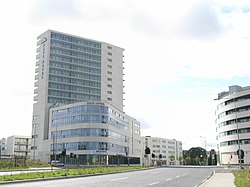Ballymun
| Ballymun Irish: Baile Munna | |
| County Dublin | |
|---|---|
 Ballymun village centre | |
| Location | |
| Grid reference: | O142401 |
| Location: | 53°23’57"N, 6°16’54"W |
| Data | |
| Population: | 21,626 (2016) |
| Postcode: | D11 / D9 |
| Dialling code: | 01 |
| Local Government | |
| Council: | Dublin |
Ballymun is a village of county Dublin which has become an outer suburb of Dublin itself, at the northern edge of the Northside.
The development of Ballymun began in the 1960s to accommodate a housing crisis in inner city areas of Dublin. The area became well known for its high-rise tower blocks and flat complexes. It has several sub-districts such as Sillogue, Coultry, Shangan and Poppintree, and is in close proximity to Dublin Airport.
In 1997, a regeneration plan was announced, which led to demolition of the flats over time and their replacement by new low-rise housing and some civic amenities, but also saw the loss of most of the area's shops. The regeneration had cost about €1 billion as of 2016.[1]
Geography
Ballymun lies on the plains of southern 'Fingal' (the southern part of County Dublin), sloping from north-west to south-east, from the catchment of the Santry River through that of the Wad River.
The Santry rises in Harristown and Dubber, north-west of Ballymun, and crosses and drains the northern parts of the district. The Wad is the area's main watershed, with branches most notably around Poppintree; it flows south-east, eventually reaching the sea at Clontarf[2]
Ballymun neighbours Finglas, Glasnevin and Santry.
History
Ballymun was historically a rural area. The nearest village was Santry, dependent on the Domville family.
By the 1960s Dublin's housing stock was not only under pressure from a rising population but was also poorly maintained. House collapses in Bolton Street and Fenian Street in 1963 led to the death of four people, forcing Dublin Corporation to adopt ‘emergency measures’ to deal with the crisis.[3]
In 1964, in a response to this housing crisis in inner city areas of the capital, plans were made to build high-rise flat complexes; construction started in 1966 and were completed by the following year. Seven 15-storey towers were built. The Poppintree area of Ballymun was constructed in the late 1970s.
Some social problems occurred in the early years, as families which had grown up in dense city terraces close to Dublin's retail core, found themselves at the edge of the city, with few amenities beyond a travelling shop. Over time, Ballymun became notorious for social problems, such as drug abuse and unemployment, and was impacted by negative media coverage of the area.
The current Ballymun district is not substantially in the townland historically called "Ballymun". Instead, it occupies several nearby townlands, the most significant of which is Stormanstown. Due to what were seen to be undesirable associations of the name, the area admitting to being Ballymun has shrunk since the completion of the tower blocks. Streets have also been renamed, for example Ballymun Avenue was renamed Glasnevin Avenue after a local plebiscite in the 1970s.
In books, television and film
- Into the West (film, 1992) was set and filmed in Ballymun.
- Family (1994 television series)
- One Day Time (1992 short film)[4]
Books
- The Mun by Lynn Connolly: a memoir covering the history of Ballymun from inception to regeneration
- Dying to Survive by Rachael Keogh: her account of her life as a heroin addict in Ballymun
- The Ballymun Trilogy by Dermot Bolger: three plays that chart forty years of life in Ballymun
Sport
- Football:
- St Pats Phoenix FC
- Ballymun United FC
- Gaelic athletics:
- Ballymun Kickhams Gaelic Football Club
- Setanta Hurling Club
Outside links
| ("Wikimedia Commons" has material about Ballymun) |
- Ballymun Regeneration Ltd, with much about all aspects of the regeneration
- Photos of the demolition of one of the flats
References
- ↑ Dublin, The Dublin Inquirer, 31 May 2016 "In Ballymun socks are scarce these days"
- ↑ Dublin, 2013: Doyle, Joseph W.; Ten Dozen Waters, 2013 (8th edition)
- ↑ "‘I personally don’t want to see another Ballymun again’: the lessons of urban planning and regeneration" (in en-US). Holinshed revisited. 27 May 2016. https://holinshedrevisited.wordpress.com/2016/05/27/i-personally-dont-want-to-see-another-ballymun-again-the-lessons-of-urban-planning-and-regeneration/.
- ↑ Day Time - YouTube
